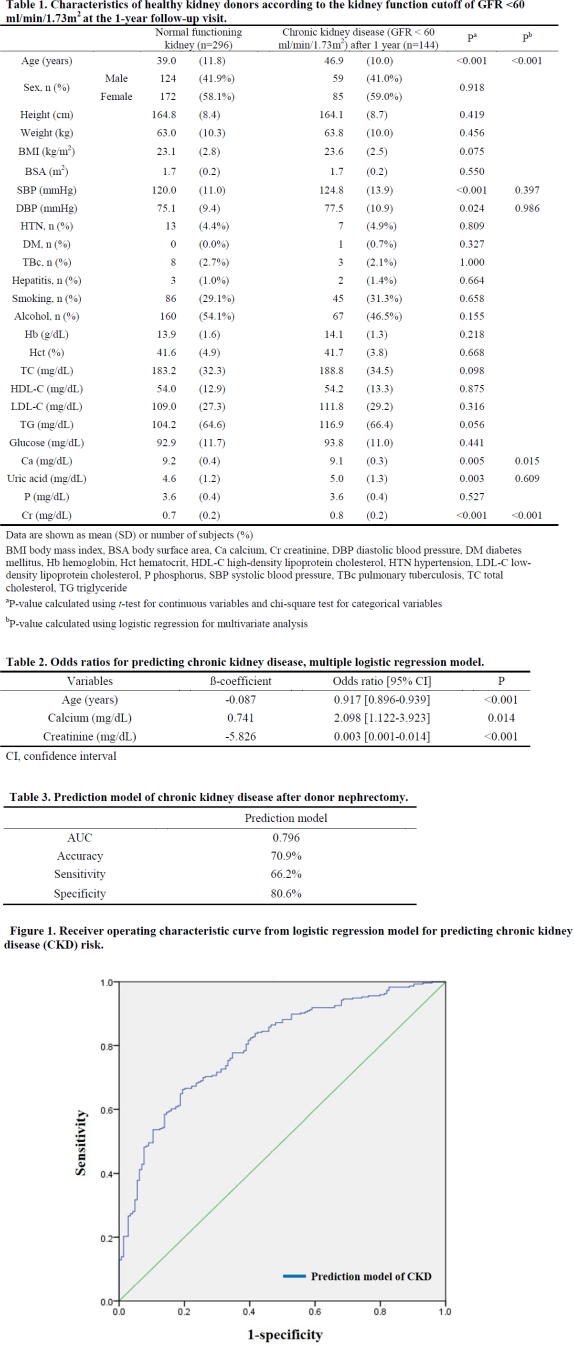Development of a Screening Tool to Predict Chronic Kidney Disease Risk in Post-Nephrectomy Living Kidney Donors
1Department of Urology, Yonsei University College of Medicine, Urological Science Institute, Seoul, Korea
2Department of Urology, National Health Insurance Service Ilsan Hospital, Goyang-si, Korea
3Department of Urology, Hanyang University Medical Center, Seoul, Korea
4Department of Surgery-Transplantation, Yonsei University College of Medicine, Seoul, Korea.
Meeting: 2018 American Transplant Congress
Abstract number: B165
Keywords: Donation, Kidney, Renal function
Session Information
Session Name: Poster Session B: Kidney Living Donor: Long Term Outcomes
Session Type: Poster Session
Date: Sunday, June 3, 2018
Session Time: 6:00pm-7:00pm
 Presentation Time: 6:00pm-7:00pm
Presentation Time: 6:00pm-7:00pm
Location: Hall 4EF
Purpose: We aimed to develop a prediction models of chronic kidney disease (CKD) for the 1-year period after donor nephrectomy in living donors.
Materials and Methods: This study examined a prospective cohort of patients who underwent donor nephrectomy between 1 March 2006 and 31 December 2016 at the Severance Hospital, Seoul, South Korea. CKD was defined as a glomerular filtration rate (GFR) <60 ml/min per 1.73 m2 or 45 ml/min per 1.73 m2. GFR was estimated using the abbreviated Modification in Diet and Renal Disease Study equation. Patients with a previous CKD history or estimated GFR <60 ml/min per 1.73 m2 were excluded, and those with 1-year post-nephrectomy follow-up were included, in the study population.
Results: Among 440 patients who underwent donor nephrectomy, 144 (32.7%) developed a first-time onset of a GFR <60 ml/min per 1.73 m2 by 1 year after surgery. Eleven (2.5%) patients developed a new onset of GFR <45 ml/min per 1.73 m2. Age (p<0.001), serum creatinine concentration (p<0.001), and calcium level (p=0.015) were significantly associated with those groups with newly-developed CKD. Our logistic regression models derived from these three variables predicted CKD with an area under the curve of 0.796, an accuracy of 70.9%, and a sensitivity of 66.2% and specificity of 80.6%.
Conclusions: We developed a model that predicted CKD risk after donor nephrectomy with good performance. This model could be used by surgeons and patients to determine whether CKD would likely develop. This information could assist with decision-making about potential donors and for surveillance of those at risk of post-nephrectomy CKD.
CITATION INFORMATION: Na J., Park J., Yoon M-.G., Lee H., Yoon Y., Huh K., Kim M., Kim S., Kim Y., Han W. Development of a Screening Tool to Predict Chronic Kidney Disease Risk in Post-Nephrectomy Living Kidney Donors Am J Transplant. 2017;17 (suppl 3).
To cite this abstract in AMA style:
Na J, Park J, Yoon M-G, Lee H, Yoon Y, Huh K, Kim M, Kim S, Kim Y, Han W. Development of a Screening Tool to Predict Chronic Kidney Disease Risk in Post-Nephrectomy Living Kidney Donors [abstract]. https://atcmeetingabstracts.com/abstract/development-of-a-screening-tool-to-predict-chronic-kidney-disease-risk-in-post-nephrectomy-living-kidney-donors/. Accessed December 16, 2025.« Back to 2018 American Transplant Congress

